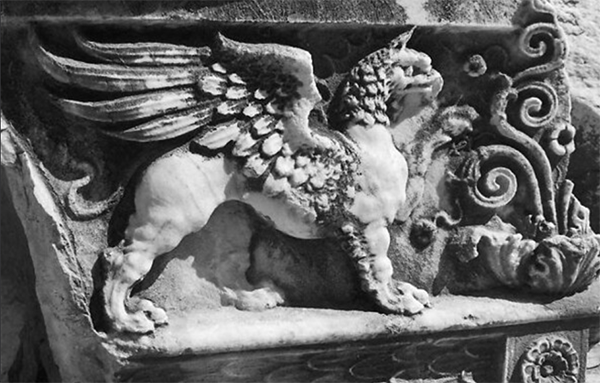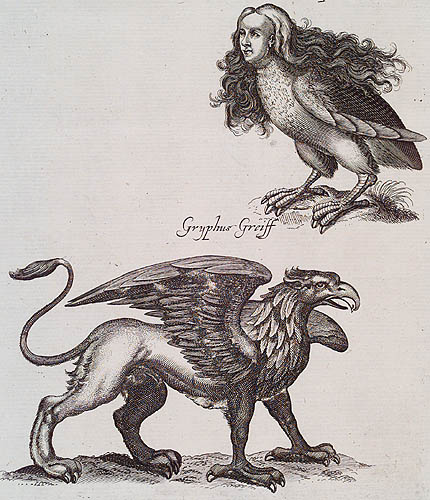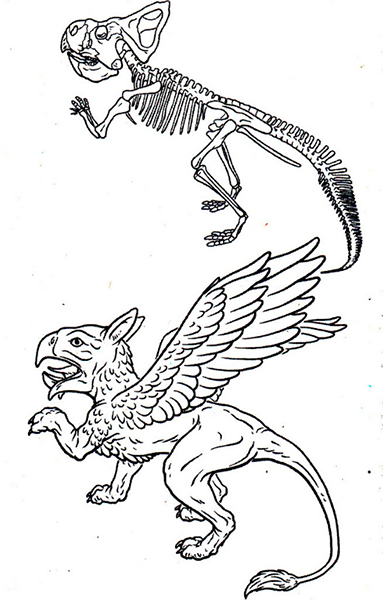The Gryphon In Legend

Griffin, Temple of Apollo, Didyma, Turkey, Chris Beckett 2019
Today we call the ancient beliefs legends, and laugh at our ancestors for regarding them as truths, even as we earnestly debate over the existence of Bigfoot, the Lock Ness Monster, and aliens from outer space. Perhaps, with all of these modern "legends", we are unconsiously respecting the awe that those before us once held for the world. Perhaps we are saddened at our swift decision to cast doubt upon that which we have never seen, and therefore do not fully understand. Perhaps there are those amongst us who still have the desire to see a unicorn rest his head in a maiden's lap, a dragon ignite the night sky with his fiery breath, or a Gryphon take flight on gilded wings...
Gryphon Origins
The origins of "mythical" creatures has been debated since the "discovery" of each one. In relation to Gryphons, not a single one of the sources in my Literature section have actually said that they had seen a live Gryphon. So how can we trust what they say? History weaves a winding trail through fact and fiction, so that hardly anyone can discern between the two. So, though the basis of my work is in presenting the facts of Gryphons, a bit of speculation and hypothesis is unavoidable. I shall endeavor to present the facts in an unbiased way, however, and leave the interpretation of those facts to each person's liberty.In order to begin to look into the origins of the Gryphon, one must first know exactly what that a Gryphon is. Seeing as how they are prominent creatures in Greek art, one would naturally think that the Greeks "created" them, which is in fact, quite false. If you look closely into Greek history and mythology, you will find little mention of Gryphons. They fought no heroes, guarded no ancient treasure, held no earthly secrets. They were treated not as legendary creatures, such as Pegasus, centaurs and the like, but as common creatures in their own time. In fact, aside from being noted as pulling the chariots of various Greek gods and goddesses, the Gryphon is no where to be found. And even that station is odd for such a fantastic creature to be debased to the status of a common beast of burden. But how could a creature so seemingly ignored in Greek mythology be so admired in their art? That is because Gryphons were never a part of Greek culture in the first place, and had come into their knowledge by tales told from those few brave enough to dare past the borders of their country to the north, in central Asia, known as Scythia to the ancient Greeks.

"Harpyea & Gryphus Greiff." Johannes Ionstonus. Historiæ Naturalis de Avibus. Francofurti ad Moenum : Matthæi Meriani, 1755.
There, the nomads who roamed the regions of the Gobi Desert and the Altai Mountains would tell tales to the Grecian travelers of fierce "griffins" in and and beyond their land, lion-like creatures with sharp eagle beaks. And seeing as how Scythia was an abundant source of gold, the nomads and the Greeks concluded that the "griffins" were attracted to the precious metal and would line their nests with it, killing all who would be foolish enough to take it away from them.
Yet the question remains, just what were the creatures that the Scythians had talked about? Were they real, or a creation of a fanciful mind? The answer could very well be either. In 2000, Adrienne Mayor, a classical folklorist, published an interesting book entitled, "The First Fossil Hunters: Paleontology in Greek and Roman Times". In that book it was her quest to show that certain creatures of Greek and Roman myth were not mere creations plucked from thin air, but were based upon the discovery of bones from long extinct creatures. And her first chapter is devoted fully to the Gryphon. Through her meticulous research and travels to Greece and beyond, Mayor discovered that there was indeed a connection between Gryphons and a type of small horned dinosaur, the protoceratops. In the image showing an artist's rendition of a protoceratops skeleton and a Gryphon, and there are astounding similarities. Both the beak and hip structures are very much like a birds, and imagination and fear helped to place the wings on the creature. Now place yourself in the place of a Scythian gold miner, walking across the harsh Gobi Desert. As you are walking you see a bleached bone jutting out of the shifting sands. Moving closer, more sand is blown from the bone, revealing a large beaked skull, too awkward and large to be any bird that you know of. You wipe off more sand from the skeleton and discover four legs and a long tail. This creature is unlike anything you've ever seen alive! You leave the skeleton behind you and when you reach civilization once more you tell of the creature you found and how it must have died guarding the abundant gold of the desert and mountain regions and... Well, you can see how legends go on from there.

"Dinosaur and griffin." Adrienne Mayor, Greek Myths: Not Necessarily Mythical. New York Times 4-7-2000. Illustrated by Ed Heck.
John Timbs also attempts to attribute the origin of the Gryphon to another animal, but his testimony is rather far-fetched and incredulous. In his book, Popular Errors Explained and Illustrated, (1856) Timbs refers to the writings of naturalist M. Roulin, who suggested that Gryphons were conceived by persons viewing a tapir as it sits, as in the illustration at right made by Roulin for his memoirs. Timbs then continues on an awkward ramble where he stretches for more information to combine the two creatures, both referring to what Roulin had said and adding his own ideas. Yet with a single sentence at the end of his section on Gryphons, he completely deteriorates his own argument. "It remains to be explained how the Tapir was known to the Greeks; whereas, at present, only three species are known, two peculiar to South America, and the third lately discovered by M. Roulin, in Malacca and Sumatra."
It is also quite possible that the Gryphon was created simply for its highly symbolic nature, as suggested by Sir Thomas Browne in his Pseudodoxia Epidemica (1646).
"The conceit of the Griffin properly taken being but a symbolical phansie, in so intollerable a shape including allowable morality."
And what more regal and majestic creature would there be than a combination of the lion, king of beasts, and the eagle, monarch of the skies? A creature that can be feared, yet also respected, powerful and vigilant, a perfect guardian of treasures and gold.
And yet, what of the possibility that Gryphons are real creatures after all? As stated before, there is little about them that is legendary. They are mortal. They live, die, give birth and raise children as any other creature would. That they guard gold is not particularly legendary, since birds of all kinds are attracted to shiny material and metals. So Gryphons would naturally be attracted to the abundant gold of the Altai Mountains and Gobi Desert, glinting in the glowing sun. Alexander Ross, Champion of the Ancients, defends the Gryphon well in his answer to Browne's work, Arcana Microcosmi (1652). In doing so he shows that there are indeed creatures that many have seen in the world which are "combination" creatures, such as bats, flying fish, the Indian Pacos, Giraffe and more. He also refers to the nature of birds to be attracted to sparkling objects, much as I have stated. Furthermore, he uses that tried but true adage of, "Just because you can't see it doesn't mean that it's not there." He suggests that perhaps the Gryphons have simply moved to higher mountains and places less accessible by Man, in order to protect themselves and their children. Just like any other animal would.
© 2019 James Spaid. All rights reserved.